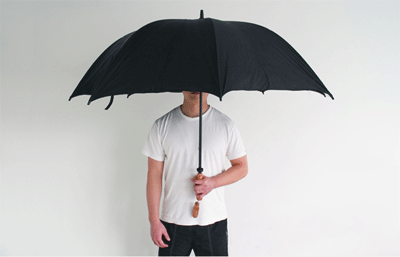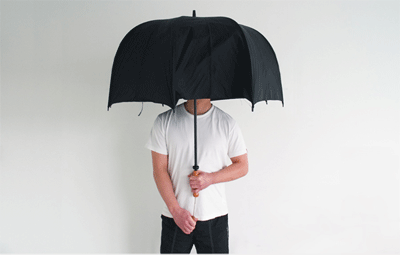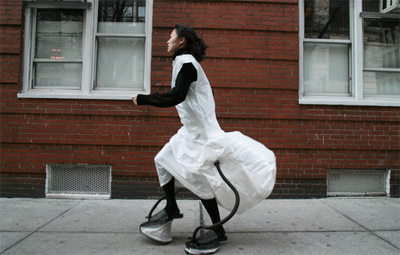

JooYoun Paek builds small, object-based responses to urban life, transforming the aches and pains we customarily suffer, at the hands of the metropolis, into novel sites of reflection, social courtesy, and rest. The artist's humorous, insightful approach bespeaks her familiarity with her subject; she was raised in Seoul, Korea, and moved to New York in 2005 to attend NYU's Interactive Telecommunications Program (ITP). Fresh from her recent participation in "Untethered," at Eyebeam, and "Design and the Elastic Mind," at MoMA, JooYoun caught up with me at her LMCC Workspace Residency studio, on the twenty-ninth floor of the Equitable Building in Manhattan's Financial District. - Tyler Coburn
What's the difference between wearable technology and what you make?
The difference? Well, I never define what I make as wearable technology. I think I'm just doing conceptual work that's wearable. Wearable technology is more about focusing on using new technology and making it fashionable, but also highly functional. I don't think my work was ever designed for utilitarian purposes. But oftentimes the methodologies of what I'm doing and wearable technology overlap, and that's why people think, on the surface, that my work is similar.
That really comes across in a piece like Polite Umbrella.
Yes. I made Polite Umbrella after I came to New York for ITP. ITP isn't really a fine art school. It focuses more on collaborative and innovative practices. We had an assignment of observing daily life and behavior, and I began to observe umbrella usage. Quite interestingly, it was the fall of 2005, which was one of the rainiest times in New York City. October was a record-breaking month. It rained almost every day. This was my first time living in New York, so I thought this was usual. Previously, I had framed myself as an artist working with sculpture and sometimes in performance and photography and video, but after going to ITP, I began to explore design. This didn't bother me that much, because the observation of life was already a part of my creative process, which either came out as very utilitarian or very expressive objects. It always started from the observation of mundane moments.
One of the things that I find interesting about this piece is that I can imagine an umbrella that just condenses uniformly, but your model responds to specific scenarios, such as a particular angle of passing. One or all sides of it can compress. So it's not just something that has a function that’s designed to meet a generic social scenario; it's something you can control on a case-by-case basis. I think that specificity is what pushes it beyond just being a quirky object.
It's not only helpful to you. It also gives a gesture to other people. I definitely involved the cultural reference of people bowing to one another in this piece.
So you see the compression of the side of the umbrella as a gesture of social politeness?
Yes. It has a morphing gesture, but conceptually it gives other people more space.
I can see a similar interest in modifying and improving everyday city life in Self-Sustainable Chair, which is also controlled by the user, yet is far more absurdist in conceit.
With this piece, I was also inspired by New York and walking in the city. I was getting sick and tired of walking the same commute route from my station stop to my home every day while carrying a heavy backpack. I wanted to make something that could make every walk I take more meaningful. The idea was very abstract, so I began to add up the days and minutes of my commute time. My walk ended up being almost fifteen full days per year. That time should be more exciting, so I made this chair. I thought that each step could generate some energy, which can then transform into something else.

It punctuates the commutes. No two walks are the same anymore, depending on when you choose to stop or pause or contemplate. I like the way that once the chair becomes full, it not only gives you the option to rest but sort of forces you to. It makes you stop for a minute. It seems like a lot of your work is about using fast-paced technologies to slow down, or as palliatives. The origami project, Fold Loud, comes to mind. You actually stitched circuits onto sheets of folded paper, such that a given user's manner of folding would close the circuits and release specific human vocal harmonies. The possible combinations aren't just beautiful to the ear; they're soothing.
There is that kind of notion.
-->-->But not, as you were saying, in a practical fashion. More in a fanciful fashion. Like Self-Sustainable Chair, this object presents a far-fetched way of relaxing, which more interestingly offsets our pace of living than an object we could buy from a store for stress relief.
Some people ask about Polite Umbrella, "So when will we see it on the market?" And I groan, "Oh, I don't really think it would work that well on the market."
I think the fact that you're not distributing them as such also lends to how they function conceptually as art-objects - to their being singular ideas manifest.
Yeah. I think it's about the statement. You mentioned the origami work. It reflects some of my personality, but this foldout doesn't really tie into my past work.
How do you mean?
It's a very design-oriented work. The object isn't really tied into any context.
Well, it's tied into a historical context.
Yes, it is tied into a historical context, but not necessarily into the daily mundane experiences that a lot of my other work ties into. So I'm having a hard time connecting it to the other work. Fold Loud was more about exploring technology with my personality, in my way. I made it as my ITP thesis project. I could have gone more in the direction of fine art, but I wanted to take the chance to use technology and see where it ended up.
But there's also an everyday reference. I grew up in the States and we didn't make origami, but we would play games with folding paper, like predicting our futures. Even origami is something that is made in Japan as a way to pass the time. So while it's definitely more of a niche reference than those in your other works, I think that there's still a connotation of the everyday. But I agree with you. It is more to the side. I don't think this means that it's more of a design object, though. I think it actually very much engages with contemporary conceptual art strategies by taking a method of folding, an idea of sound production, and the idea of origami as hardware, and drawing an axis between these points. This seems like a very contemporary approach. I couldn't speak to how much it engages with the design world, but I think it's very relevant to contemporary art.
Yes, thank you.

In the text on your website, you describe the work as having a "meta-technological aesthetic." What do you mean by that?
The technology isn't hidden. It forms the exposed circuits, so you can actually see how it's working. The technology is bubbling up. It has a different sensibility than most devices, where things are hidden behind a button and you don't know how you trigger the events on the screen.
So given that Fold Loud marks something of a departure form previous work, has the stuff you've been making since been more in line with it?
What's interesting is that I'm still working in the way I used to, and Fold Loud is developing as a side-project. For the Eyebeam Fall show, "Untethered," I had two pieces. One was called Not-Bicycle Cover, which is a bicycle cover that camouflages your bike. It's a small cover that looks like a pile of garbage bags that you can unfold, pump up, and inflate. The other project was called Nothing In It. It's a little bag, and when you open it, it releases the sound of objects. When you close it, they disappear. And when you open it again, you hear different sounds. But when you look into the bag, you see that there's nothing in it.
Are all the sounds from public, urban space?
There are a lot of these sounds. There is also the sound of a ticking clock.
What informed the sounds that you used?
I was thinking a lot about this. Should I have the sound of someone telling a story? Should I have the sound of someone singing? I actually tried to minimize that effect and use the sounds of random objects to not convey too much of a specific story. With a story you have to listen from the beginning to the end, but these sounds should make sense anytime you open the bag.
All the sounds are also things that might be heard as the bag is carried around, so it seems appropriate to collapse them into a mobile, personal belonging. It makes it seem like the sounds you hear have actually been collected by the bag.
Interesting.
So I have to ask: how was it practically made, given that you can't see anything inside?
I ideally wanted everything to be self-contained within the bag, but for this show I had to make it quickly, so the audio system is beneath the pedestal and the bag is made with a zipper sensor. The concept of the piece relates to the idea that what's in the world is only there because of your belief, and if you start to believe in different ways, things will change. So it was about making you recognize the notion of what you’re believing in - that your belief is really creating the world. Nothing else.


I'm a recent member of Rhizome. I like every interview I had read here. Until this lady Paek.
I found that most of her stuff is just a copy of other things. The inflatable chair, for example, can be found exactly on the "101 Unuseless Japanese Inventions: The Art of Chindogu" a 2000 (i belive) publication, as well as the idea of the umbrella and some other of "her inventions". The lack of consistence on her work, conceptually speaking and the mixture of things form here and there, makes me doubt of the originality of some other ideas, such as the origami work, which has nothing to do with the other stuff she shows here.
I'm tired of reading and looking to design as Art, making people to be confused about it.
Some people are just looking for fame, and not really thinking on giving creative answers.
The world is about to explode, and we have to fill our heads with more and more warm gadgets.
Enough!
Interesting.
While I do absolutely agree that the world faces large problems and that the role of design should be forcefully stronger in helping solve them, that in no way illigitimizes the need for conceptual or artistic design. In fact, as in science, many useful discoveries come from this type exploration as much as much as they do from pointed purposeful problem solving.
My analysis of your commentary is that you likely do not create things, and obviously have little to no experience being a purposeful critic either. What is the artist to do with your commentary and in what way is what you have said here constructive? How does it represent an understanding of her work and possibly help to inform or steer it into this realm of design you hope to achieve? Furthermore, since when does consistency from project to project have anything to do with an ability to be conceptual? Is a young artist or designer less valuable or capable because they don't have a consistent body of work?
Anybody can get on here and make blanket generalized statements like yours, but they don't help, and surely aren't purposeful.